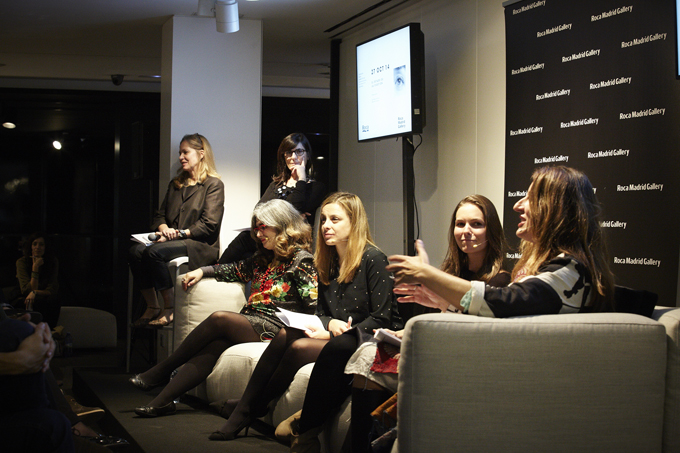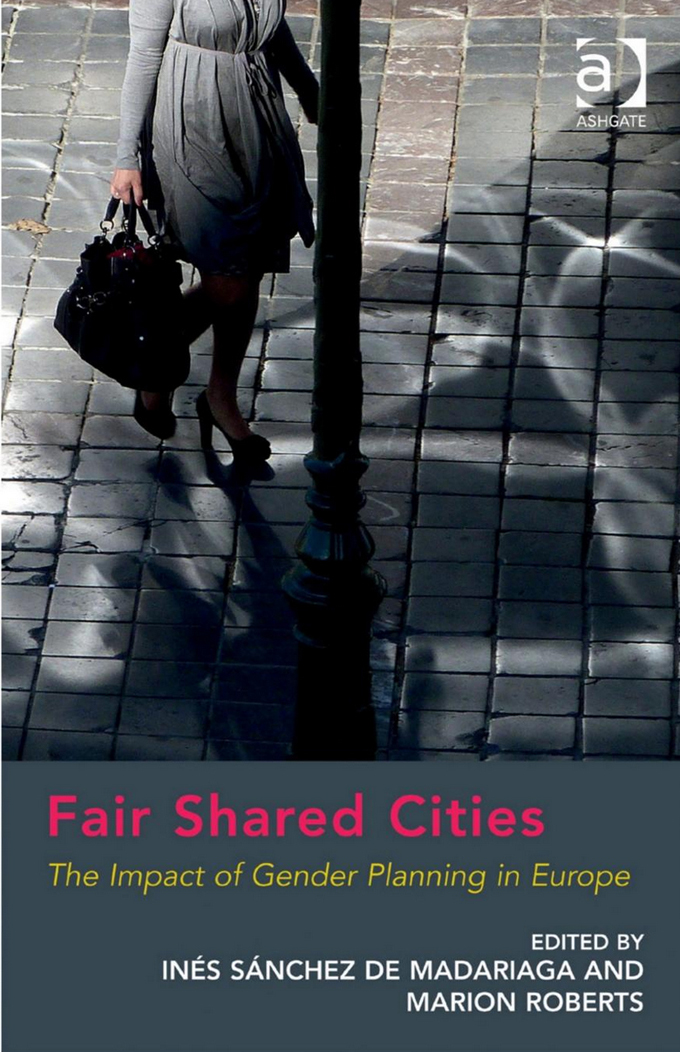"Don’t lose the talent or leave it invisible". It’s a phrase that I caught from the first words of the presentation of Martha Thorne, executive director of the Pritzker Prize, and curator, along with Ariadna Cantis, of "Spaces for Female Architects," a series of conversations with important and talented women of the world of architecture. In the large sofa of the “Salón Talk” in “Madrid Roca Gallery" sat Inés Sánchez de Madariaga, Nuria Alvarez Lombardero, Aurora Adalid and Benedetta Tagliabue. They were protagonists of an interesting discussion on the "State of the Art". This review is another effort to visualise the actions by women who believe in the necessity of the effort for gender equality.
Each space deserves an interpretation. Outside Madrid Roca Gallery, a giant LED screen communicates in its main facade the event. Inside, the gallery welcomes its visitors with an exhibition space of bath pieces. Their silhouettes aptly glimpse through translucent silver curtains, prompting an ambiguity between a domestic modesty and the expositive exhibitionism that the place requires. After the colloquium, Antonio Lamela, architect of the project of the Madrid Roca Gallery, said that to overcome the problem of the invisibility of women in the profession, "She shouldn’t be modest" ... of her work, of course. It is a good point of view: part of the lessons of modernity is that being modern means to be involved in media. It comes to my mind that image of a nude Le Corbusier painting one of the murals of the house E.1027 by the architect Eileen Gray; a media exhibitionism parallel to the hidden work of Grey for many years.
Let’s go back to the gallery. The showpiece, without any veil, is the bathtub "dama retro" designed by Giorgetto Giugiario (awarded "Car Designer of the Century” in 1999). Inevitably I draw in my mind the iconic image of a woman spreading her long legs from the foam. This image seeped into our heads because of the sexist and / or hedonistic post-war advertising in which the woman was sexualised in order to reinforce her role as mother and homemaker. I think about these suggestive ambiguities and how this protagonist bathtub led me to draw a stereotype. This stereotype of the sexualized woman was the one that once cause the denial of this image by feminist groups, as part of their struggle, so they adopted the opposite image: the masculinised woman. This was the image -physical or behavioral- adopted by most of the female architects of the twentieth century who had a place in the higher levels of the profession. I think nowadays women, in a range of possibilities, can choose her image by option and not by work or social obligations or conditions…
This is just the beginning of this review of an evening of reflections, new links and empathies. I have decided to split it into three parts: femininity, feminism and feminisation.

From left to right: Martha Thorne, Ariadna Cantis, Inés Sánchez de Madariaga, Nuria Álvarez Lombardero, Aurora Adalid, Benedetta Tagliabue. Photo courtesy of Madrid Roca Gallery.
FEMININITY
Benedetta Tagliabue explains that a position of power in a woman is not accepted by society because it is not sexy. The audience laughs, although she and the other guests, very feminine architects, don’t fit the stereotype. The presence of Benedetta was very positive. Maybe she felt -or maybe she already knew ...- she will be chosen as jury of the Pritzker Prize the next day. She highlighted the resilience of woman and her intuition, that "immediate intelligence" that has made today even manmade architectures being more feminine, like the skin of the buildings or the metaphors that make a wink to some domestic labors, as knitting. Somehow, we always derive in domestic issues; it may be because it exemplifies many of the conflicts of the patriarchal structure, as when Benedetta talks about the fact of setting the table (constructing it) every night for dinner in a sort of fugacious act that disappears as easier as it was placed. But the transience of female presence in the act of building architecture and making cities, currently has a better picture, "there haven’t been far better time for women in society" she said.
Is it a matter of time to reach gender parity in the profession? No. In fact this encouraging testimony of Benedetta doesn’t encourage to stay on hold. Her case is an island in a context where female architects are facing difficult and precarious employment conditions, a high desertion from the profession as the years pass, as well as the presence of a few examples of professional independence. To these factors, we have to add: a high degree of denial of the problem, even by women. I have personally seen it when I write about these issues: men mostly say it's a matter of personal perception, while women prefer not to speak out. We should ask why, Martha Thorne told me. Later, in a personal conversation, Aurora Adalid tells me: the review or discussion about gender means showing vulnerability and it has even been said that it is a matter of bad self esteem. For many women it is more effective to dodge the subject than losing position scales, appearing vulnerable or -invoking the harshest stereotypes- unfeminine.

Conceptual drawing. Metro station Clichy-Montfermeil, Paris. Miralles Tagliabue EMBT & Bordas +Peiro.

Conceptual Collage. Metro station Clichy-Montfermeil, Paris. Miralles Tagliabue EMBT & Bordas +Peiro.
FEMINISM
Why some people deny something that is so dormant? Inés Sánchez de Madariaga points out that there is a "cognitive dissonance". Cognitive dissonance is a conflict between two incompatible thoughts because of ingrained cultural belief systems and preconceived ideas that in the case of the feminist struggle cause an internal conflict on a woman, leading her to question whether it is necessary to join to the battle, although its causes are evident.
Inés lists several of them: unadapted and often hostile labor environments for women with family responsibilities, stereotypes and gender biases, including double standards and double binds, the historiographical practices and architectural criticism that mythologized the figure of the architect and his / her subsequent association with the star system. This star system has systematically invisible women through the concealment of the collaborative work that architecture involves, giving credit and fame to just one person. We can find an example in the documentary film "My Architect. A son's journey". In this documentary, Nathaniel Kahn, son of Louis Kahn, claimed the role of three of the most important women in his father’s life. They were sentimental and work fellows (one of them was her mother), who actively collaborated on his projects and didn´t received credit for it.
These causes could be considered as subjective if it weren’t for the statistics. Inés has conducted a lot of research on women in Spanish architecture since 2000. The statistical data of her work shows the little vertical integration and the complexities of female architects. In the School of Architecture of Madrid, for example, for every 2.3 male teachers there is a professor, but for women every 11. The School of Architecture of Madrid has only 2 female professors, one about to retire. The fields where the situation of women is worse, is in Architectural Design; only two professors in Spain, and in Urbanism, only one. Despite the intense feminisation of the career in recent years, where 60% of students are women, only 4% of the chairs were occupied by them. There is a rate indicator defined by the European Commission called the "glass ceiling", which measures the probability of promotion between men and women. The glass ceiling is a hard limit to trespass on the career of woman, preventing her to achieve professional goals for which, despite she is amply prepared, the structures, stereotypes and biases prevent her rise to the highest levels of the profession. A glass ceiling index equal to 1 indicates no bias in the promotion of women and men. What is really striking is that the School of Architecture of Madrid glass ceiling index is particularly high, exceeding 8. The average of this index for the whole Polytechnic University is below 2.5, while for all fields of knowledge throughout the country is slightly above 2. This index is a very clear measure of the extent of the problem women have in architecture.

“Fair Shared Cities. The Impact of Gender Planning in Europe”. Edited by Inés Sánchez de Madariaga and Marion Roberts. Ashgate, Aldershot-New York, 2013.
FEMINISATION
The data show that the feminisation of the career is imminent. In the Spanish version of this article, I explain that despite this, many people insist on not using the feminine form of the word. Of course it doesn’t happen in English. In Spanish, it is funny how the dictionary of the Real Academia Española de la Lengua, RAE, includes the word in male and female (arquitecto, ta.) but below adds: "Also used in the masculine form to designate the female. Laura es arquitecto. "It was Aurora Adalid, who emphasized in the importance of language and the feminisation of the term, and in the importance of horizontal roles in architectural studios.
There is no doubt that the problem exists. In Spain, says Inés, despite the feminisation of the career, at the senior levels of the profession the vertical integration of women hasn’t advanced in the last 20 years. This shows that it is not a matter of time; action is required. Fortunately there are those who have taken this matter in a specialized way, as Nuria Alvarez Lombardero who after completing his PhD thesis on architecture and gender, organizes a specialized Academic Congress in which interesting issues in the area are addressed. The next congress will be held in Lisbon in 2015. The first (Sevilla, 2013) also emphasized in the feminisation of the word in the Spanish language (ArquitectAs). Nuria seeks an explanation for the absence of men at the congress; perhaps because of the subject or the context in general. Although it is noteworthy the male presence in the colloquium now I review. Male participation in such meetings is essential, since the integration and understanding of the problem is sought from this hegemonic counterpart, who in a great extent, are interested in maintaining the status quo.
Inés raised some solutions: meet the reality, release data and gender studies and publish them, get support at the highest levels of decision, review the organisation of work from a perspective that takes into account family situations. "Quality = Equality", she concludes. The feminisation of labor spheres of architecture is a latent goal. We need to put in crisis the strong social and occupational roles, demystify the architect and his/her obsession with the productive life and to understand that today there are feminine values that are no longer tangential but principal values of the profession. From the most raw and scathing point of view, equity will arrive when a mediocre woman can access the same positions than mediocre man. But the emphasis must be put on "Quality and Equality". To the opening phrase "Don’t lose the talent or leave it invisible" I should add: "Do not deny the problem, or abandon excellence."


















![10 Architecture Studios Led by Women [II] 10 Architecture Studios Led by Women [II]](/sites/default/files/styles/mopis_home_news_category_slider_desktop/public/metalocus_women-arch-2016_eng-8_0.png?h=5c593260&itok=Wb9aNuM7)





